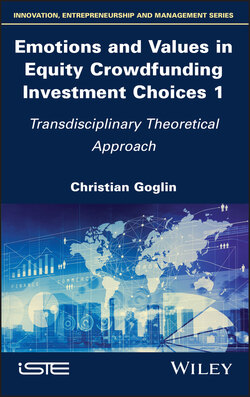Emotions and Values in Equity Crowdfunding Investment Choices 1

Реклама. ООО «ЛитРес», ИНН: 7719571260.
Оглавление
Christian Goglin. Emotions and Values in Equity Crowdfunding Investment Choices 1
Table of Contents
List of Illustrations
List of Tables
Guide
Pages
Emotions and Values in Equity Crowdfunding Investment Choices 1. Transdisciplinary Theoretical Approach
Acknowledgments
Introduction
Research context
Purpose of the research
Methodology
Expected contributions
General structure
1. Equity Crowdfunding, a New Form of Financing that Raises a Number of Questions
1.1. Equity crowdfunding, a new way of financing companies
1.1.1. Definition, emergence and state of play on crowdfunding. 1.1.1.1. Definition
1.1.1.2. Brief historical perspective on crowdfunding
1.1.1.3. State of play of crowdfunding
1.1.1.3.1. Crowdfunding figures for Europe
1.1.1.3.2. Crowdfunding figures for France
1.1.2. Equity crowdfunding within the crowdfunding family. 1.1.2.1. Presentation of equity crowdfunding
1.1.2.2. Operation and business model of the platforms. 1.1.2.2.1. Operation
1.1.2.2.2. Business model
1.1.2.3. Advantages/disadvantages of equity crowdfunding
1.1.2.3.1. Benefits for entrepreneurs
1.1.2.3.2. Disadvantages for entrepreneurs
1.1.2.3.3. Advantages for investors
1.1.2.3.4. Disadvantages for investors
1.1.2.4. Some figures for the French equity crowdfunding industry
1.1.3. The regulatory framework for equity crowdfunding
1.1.3.1. The European regulatory framework
1.1.3.2. The French regulatory framework
Box 1.1. Investor information
Box 1.2. Investment advice and suitability testing
1.1.3.3. The US regulatory framework
1.1.4. The crowd of investors
1.1.5. The risks of equity crowdfunding for the individual investor
1.1.6. In conclusion
1.2. A success that raises questions about the rationality of investors
1.2.1. Elements of explanation for a surprising success. 1.2.1.1. Surprising success
1.2.1.2. Psychological explanations: the motivations of equity crowdfunding investors
1.2.1.3. Sociological explanations: the social dimension of successful fundraising campaigns
1.2.1.4. The two levels of choice of these explanations
1.2.2. An emotional dimension not very present in the explanations of the investor’s choice
1.2.2.1. How choice is handled in the literature on equity crowdfunding in entrepreneurial finance
1.2.2.2. A choice made in the context of persuasive advertising
1.2.2.3. The importance of emotional reactions
1.2.2.4. The absence of affective reactions in academic work on equity crowdfunding
1.2.3. In conclusion
1.3. What role for values and the affect? 1.3.1. Issue. 1.3.1.1. Justification
1.3.1.2. Presentation of the problem. 1.3.1.2.1. Research object (problem)
1.3.1.2.2. Central issue
1.3.1.2.3. Secondary issue
1.3.1.2.4. Defended thesis
1.3.1.2.5. Remarks
1.3.1.3. Delimitation of the field of research
1.3.1.3.1. A contextual choice
1.3.1.3.2. A second-order choice
1.3.1.3.3. No sociological or psychoanalytical approach
1.3.1.4. Methodology
1.3.1.5. Organization of research
1.3.2. To summarize
1.4. Conclusion
2. Transdisciplinary Approach to the Issue of Investor Choice
2.1. Objective and methodology. 2.1.1. Objective
2.1.2. Methodology
2.2. Theories that can be used to explain the choice of investors
2.2.1. Choice as a rational decision: expected utility theory. 2.2.1.1. A normative theory
Box 2.1. The St. Petersburg paradox behind the utility function
2.2.1.2. The absence of the affective dimension of the original theories in the expected utility theory
2.2.1.3. The explanatory weakness of expected utility theory in the face of choices based on complex rationality
2.2.2. Emotions, affective reactions and other affective experiences
2.2.2.1. Affective reactions
2.2.2.2. Emotions
2.2.2.3. Moods
2.2.2.4. Preferences
2.2.3. Affect in the models of the judgment and decision-making field. 2.2.3.1. Perspectives on decision-making models
2.2.3.2. The affect in a normative model: regret theory
2.2.3.3. Empirical explanatory models. 2.2.3.3.1. The prospect theory
2.2.3.3.2. The choosing-by-liking hypothesis
2.2.3.3.3. The choice and the relative pleasure of consequences approach
Box 2.2. Illustration of anticipated pleasure theory
2.2.3.3.4. The affect-as-information approach
2.2.3.3.5. The risk-as-feeling theory
2.2.3.3.6. Feeling-is-for-doing approach
2.2.3.3.7. Affect heuristics
2.2.3.3.8. The somatic marker hypothesis
2.2.4. Affects in finance
2.2.4.1. The choice of investment in entrepreneurial finance
2.2.4.1.1. IDM in BA and VC
2.2.4.1.2. Emotional contagion and persuasion through crowdfunding
2.2.4.2. Affective states in capital market literature
Box 2.3. Separate consideration of moods and emotions in understanding investment choice
2.2.4.2.1. Investor emotions
2.2.4.2.2. The affect heuristic
2.2.5. Emotional aspects of consumer purchasing behavior
2.2.5.1. Persuasive advertising: a push effect
2.2.5.2. The affective halo
2.2.5.3. Means-end chain model and the role of values
2.2.6. Organizational attractiveness and PO-fit: a pull effect. 2.2.6.1. Organizational attractiveness
2.2.6.2. The P-O fit as a basis for organizational attractiveness
2.2.6.3. The values and theories of cognitive consistency as a basis for P-O fit
2.2.7. Psychology, emotions and values. 2.2.7.1. System 1/system 2
2.2.7.2. The anchoring phenomenon
2.2.7.3. The determinants of emotions: the cognitive evaluation theory
2.2.7.4. From values to emotions. 2.2.7.4.1. Value theory
2.2.7.4.2. Link between values and emotions
2.2.7.5. Emotions, motivations and action tendency
2.3. Toward a concise theoretical framework
2.3.1. Theoretical framework
2.3.2. Articulation of concepts and theories
2.3.3. Disciplinary breakdown of concepts and theories
2.3.4. Conclusion
References
Index. A
B, C
D, E
F
H, I
L, M
N, O, P
R
S
U
V
2020
2019
2018
2017
2016
2015
2014
2013
2012
2011
2010
2009
2008
2007
2006
WILEY END USER LICENSE AGREEMENT
Отрывок из книги
Christian Goglin
.....
In the field of entrepreneurship, several authors examined the effects of entrepreneurial affect (Milovac et al. 2015), pitch (Davis et al. 2017) and narrative emotions (Wuillaume et al. 2016) on investors; their evaluation; and their choices. In addition, Allison et al. (2017) studied the phenomenon of persuasion that is at play between entrepreneurs and investors.
In the field of human–computer interaction, Josue and Bahm (2016) propose a method for measuring the emotional impact of pitch videos on sponsors, in line with the results uncovered in the field of marketing regarding the impact of videos on consumer attitudes (Graillot 1996).
.....